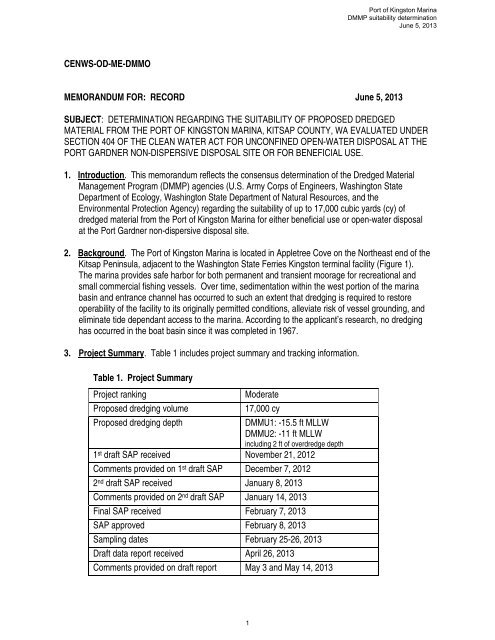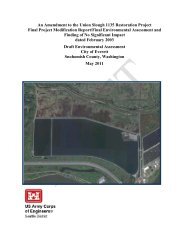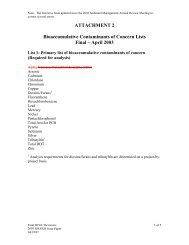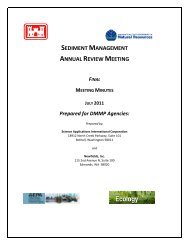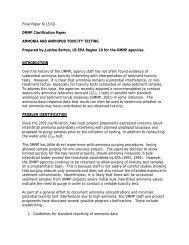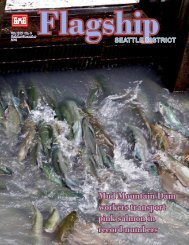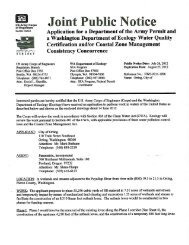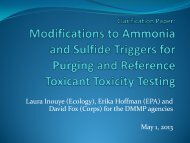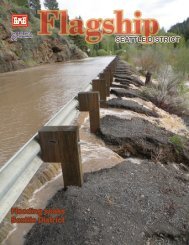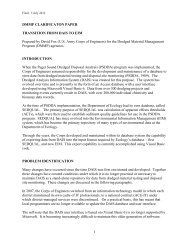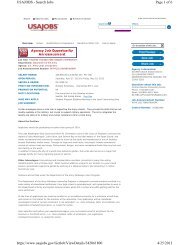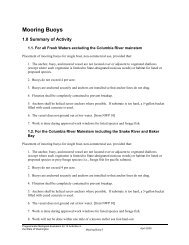Port of Kingston Marina, Kitsap County - Seattle District - U.S. Army
Port of Kingston Marina, Kitsap County - Seattle District - U.S. Army
Port of Kingston Marina, Kitsap County - Seattle District - U.S. Army
Create successful ePaper yourself
Turn your PDF publications into a flip-book with our unique Google optimized e-Paper software.
<strong>Port</strong> <strong>of</strong> <strong>Kingston</strong> <strong>Marina</strong><br />
DMMP suitability determination<br />
June 5, 2013<br />
CENWS-OD-ME-DMMO<br />
MEMORANDUM FOR: RECORD June 5, 2013<br />
SUBJECT: DETERMINATION REGARDING THE SUITABILITY OF PROPOSED DREDGED<br />
MATERIAL FROM THE PORT OF KINGSTON MARINA, KITSAP COUNTY, WA EVALUATED UNDER<br />
SECTION 404 OF THE CLEAN WATER ACT FOR UNCONFINED OPEN-WATER DISPOSAL AT THE<br />
PORT GARDNER NON-DISPERSIVE DISPOSAL SITE OR FOR BENEFICIAL USE.<br />
1. Introduction. This memorandum reflects the consensus determination <strong>of</strong> the Dredged Material<br />
Management Program (DMMP) agencies (U.S. <strong>Army</strong> Corps <strong>of</strong> Engineers, Washington State<br />
Department <strong>of</strong> Ecology, Washington State Department <strong>of</strong> Natural Resources, and the<br />
Environmental Protection Agency) regarding the suitability <strong>of</strong> up to 17,000 cubic yards (cy) <strong>of</strong><br />
dredged material from the <strong>Port</strong> <strong>of</strong> <strong>Kingston</strong> <strong>Marina</strong> for either beneficial use or open-water disposal<br />
at the <strong>Port</strong> Gardner non-dispersive disposal site.<br />
2. Background. The <strong>Port</strong> <strong>of</strong> <strong>Kingston</strong> <strong>Marina</strong> is located in Appletree Cove on the Northeast end <strong>of</strong> the<br />
<strong>Kitsap</strong> Peninsula, adjacent to the Washington State Ferries <strong>Kingston</strong> terminal facility (Figure 1).<br />
The marina provides safe harbor for both permanent and transient moorage for recreational and<br />
small commercial fishing vessels. Over time, sedimentation within the west portion <strong>of</strong> the marina<br />
basin and entrance channel has occurred to such an extent that dredging is required to restore<br />
operability <strong>of</strong> the facility to its originally permitted conditions, alleviate risk <strong>of</strong> vessel grounding, and<br />
eliminate tide dependant access to the marina. According to the applicant’s research, no dredging<br />
has occurred in the boat basin since it was completed in 1967.<br />
3. Project Summary. Table 1 includes project summary and tracking information.<br />
Table 1. Project Summary<br />
Project ranking<br />
Moderate<br />
Proposed dredging volume<br />
17,000 cy<br />
Proposed dredging depth<br />
DMMU1: -15.5 ft MLLW<br />
DMMU2: -11 ft MLLW<br />
including 2 ft <strong>of</strong> overdredge depth<br />
1 st draft SAP received November 21, 2012<br />
Comments provided on 1 st draft SAP December 7, 2012<br />
2 nd draft SAP received January 8, 2013<br />
Comments provided on 2 nd draft SAP January 14, 2013<br />
Final SAP received February 7, 2013<br />
SAP approved February 8, 2013<br />
Sampling dates February 25-26, 2013<br />
Draft data report received April 26, 2013<br />
Comments provided on draft report May 3 and May 14, 2013<br />
1
<strong>Port</strong> <strong>of</strong> <strong>Kingston</strong> <strong>Marina</strong><br />
DMMP suitability determination<br />
June 5, 2013<br />
Final data report received May 31, 2013<br />
EIM Study ID<br />
DMMP-POKMA-A-334-13<br />
USACE Permit Application Number NWS-2012-1110<br />
Recency Determination (rank = 5 years) February 2018<br />
4. Project Ranking and Sampling Requirements. This project was ranked moderate by the DMMP<br />
agencies according to the guidelines set out in the User’s Manual for marinas. In a moderateranked<br />
area the number <strong>of</strong> samples and analyses are calculated using the following guidelines<br />
(DMMP, 2008a):<br />
• Maximum volume <strong>of</strong> sediment represented by each field sample = 4,000 cubic yards<br />
• Maximum volume <strong>of</strong> sediment represented by each analysis in the upper 4-feet <strong>of</strong> the<br />
dredging prism (surface sediment) = 16,000 cubic yards<br />
• Maximum volume <strong>of</strong> sediment represented by each analysis in the subsurface portion <strong>of</strong> the<br />
dredging prism = 24,000 cubic yards<br />
Due to the unusual configuration <strong>of</strong> the project and the need to dredge the entire depth <strong>of</strong> the prism<br />
starting at the entrance channel in order to provide sufficient depth to maneuver the dredge near the<br />
boat ramp, the project was divided horizontally into two full depth DMMUs.<br />
5. Sampling. Sampling took place February 25-26, 2013 and the approved sampling and analysis<br />
plan (SAP) was generally followed (Grette Associates, 2013). See Table 2 for sample coordinates<br />
and compositing information and Figure 2 for sample locations within the project area. Generally,<br />
two vibracores were collected from each DMMU and composited for a single analysis. Z-samples<br />
were collected from three locations and archived individually.<br />
Due to inclement weather and the nature <strong>of</strong> the fine sand in the project area, there were significant<br />
difficulties getting the required core percent recoveries. Real-time coordination with the DMMO<br />
occurred according to the procedures outlined in the SAP, and multiple coring attempts were made<br />
at each sampling station. As a result <strong>of</strong> the inability to retrieve sufficient material in the core barrel<br />
at station SS-3 after four attempts, with DMMO approval, this station was abandoned and not<br />
included in the composite for DMMU 2.<br />
Also as a result <strong>of</strong> the sampling difficulties, the depths <strong>of</strong> the samples collected varied from the<br />
compositing scheme outlined in the SAP. These deviations are shown in Table 2. Briefly, material<br />
from core S-2 was collected 2.6 ft deeper than the design depth, core S-4 was shorter than the<br />
design depth by 4.6 ft and core S-5 included material from 0.6 ft deeper than the design depth.<br />
The DMMP agencies determined, based on the results <strong>of</strong> the chemical analysis, that the deviations<br />
from the sampling plan outlined above did not significantly affect the representativeness <strong>of</strong> the<br />
samples or the usability <strong>of</strong> the data generated.<br />
6. Chemical Analysis. All analyses were conducted by Analytical Resources, Inc <strong>of</strong> Tukwila, WA. The<br />
approved SAP was followed and quality control guidelines specified by the DMMP program were<br />
generally met. The conventional and chemical results compared to DMMP guidelines are presented<br />
in Table 3. The grain size data show the proposed dredged material is predominantly sand, with a<br />
2
<strong>Port</strong> <strong>of</strong> <strong>Kingston</strong> <strong>Marina</strong><br />
DMMP suitability determination<br />
June 5, 2013<br />
fines fraction ranging from 7.2 to 13.3%. The total organic carbon content ranged from 0.33 to<br />
0.68%. The chemistry results show there were no detected or undetected exceedances <strong>of</strong> DMMP<br />
screening levels or bioaccumulation triggers for the standard DMMP chemicals <strong>of</strong> concern in either<br />
DMMU (DMMP, 2011). Tributyltin analysis was also conducted in both DMMUs. There was<br />
insufficient porewater in the samples, so bulk TBT analysis was conducted. TBT was undetected in<br />
both DMMUs at levels well below the screening level value <strong>of</strong> 73 µg/kg dry weight.<br />
Both DMMUs were also compared to the Sediment Management Standards (Ecology, 1995), see<br />
Table 4. All results were below the SQS, with the exception <strong>of</strong> hexachlorobenzene, which was<br />
undetected at the reporting limit above the SQS in both DMMUs. The laboratory determined that<br />
there was no evidence that hexachlorobenzene was present in the samples at the lower detection<br />
limit (MDL), and the samples were flagged as UJ at the detection limit, which is below the SQS in<br />
both DMMUs.<br />
7. Sediment Exposed by Dredging. The DMMP antidegradation guidelines (DMMP, 2008b) state<br />
that chemical analysis <strong>of</strong> the z-sample is required if the testing results for the overlying sediment are<br />
a) found to be unsuitable for unconfined aquatic disposal, b) if any other project in the same water<br />
body has shown evidence <strong>of</strong> subsurface sediment with greater contamination than surface<br />
sediment, or c) if there is any other site-specific reason to believe that the sediment to be exposed<br />
by dredging may fail to meet the antidegradation policy. Since there were no SQS exceedances in<br />
the dredge prism, the DMMP agencies determined that z-sample analysis was not required for this<br />
project.<br />
As demonstrated by the site history and by the results <strong>of</strong> the above analyses, the sediment to be<br />
exposed by dredging is not anticipated to be degraded relative to the currently exposed sediment<br />
surface. On this basis the DMMP agencies conclude that this project is in compliance with the State<br />
<strong>of</strong> Washington anti-degradation policy.<br />
8. Suitability Determination. This memorandum documents the evaluation <strong>of</strong> the suitability <strong>of</strong><br />
sediment proposed for dredging from the <strong>Port</strong> <strong>of</strong> <strong>Kingston</strong> <strong>Marina</strong> for beneficial use or open-water<br />
disposal at the <strong>Port</strong> Gardner non-dispersive disposal site. The approved sampling and analysis<br />
plan was generally followed. The data gathered were deemed sufficient and acceptable for<br />
regulatory decision-making under the DMMP program.<br />
In summary, based on the results <strong>of</strong> the previously described testing, the DMMP agencies conclude<br />
that all 17,000 cy <strong>of</strong> dredged material are suitable for open-water disposal at the <strong>Port</strong> Gardner<br />
non-dispersive site or in-water beneficial use. A determination regarding upland beneficial use<br />
should be coordinated with the local health jurisdiction.<br />
This suitability determination does not constitute final agency approval <strong>of</strong> the project. During the<br />
public comment period that follows a public notice, the resource agencies will provide input on the<br />
overall project. A final decision will be made after full consideration <strong>of</strong> agency input, and after an<br />
alternatives analysis is done under section 404(b)(1) <strong>of</strong> the Clean Water Act.<br />
A pre-dredge meeting with DNR, Ecology and the Corps <strong>of</strong> Engineers is required at least 7 days<br />
prior to dredging. A dredging quality control plan must be developed and submitted to the<br />
3
<strong>Port</strong> <strong>of</strong> <strong>Kingston</strong> <strong>Marina</strong><br />
DMMP suitability determination<br />
June 5, 2013<br />
Regulatory Branch <strong>of</strong> the <strong>Seattle</strong> <strong>District</strong> Corps <strong>of</strong> Engineers at least 7 days prior to the pre-dredge<br />
meeting. A DNR site use authorization must also be acquired.<br />
9. References.<br />
DMMP, 2011. Marine Sediment Quality Screening Levels: Adopting RSET Marine SLs for Use in<br />
DMMP. A Clarification Paper prepared by Laura Inouye (Ecology) and David Fox (USACE) for the<br />
Dredged Material Management Program, June 2011.<br />
DMMP, 2008a. Dredged Material Evaluation and Disposal Procedures (Users Manual). Prepared<br />
by the <strong>Seattle</strong> <strong>District</strong> Dredged Material Management Office for the Dredged Material Management<br />
Program, July 2008.<br />
DMMP, 2008b. Quality <strong>of</strong> Post-Dredge Sediment Surfaces (Updated). A Clarification Paper<br />
Prepared by David Fox (USACE), Erika H<strong>of</strong>fman (EPA) and Tom Gries (Ecology) for the Dredged<br />
Material Management Program, June 2008.<br />
Ecology, 1995. Sediment Management Standards – Chapter 173-204 WAC. Washington State<br />
Department <strong>of</strong> Ecology, December 1995.<br />
Grette Associattes, 2013. <strong>Port</strong> <strong>of</strong> <strong>Kingston</strong> <strong>Marina</strong> Maintenance Dredge Sampling and Analysis<br />
Plan. January 2013.<br />
4
<strong>Port</strong> <strong>of</strong> <strong>Kingston</strong> <strong>Marina</strong><br />
DMMP suitability determination<br />
June 5, 2013<br />
10. Agency Signatures.<br />
Concur:<br />
___________<br />
Date<br />
________________________________________________<br />
Kelsey van der Elst - <strong>Seattle</strong> <strong>District</strong> Corps <strong>of</strong> Engineers<br />
___________<br />
Date<br />
________________________________________________<br />
Justine Barton - Environmental Protection Agency<br />
___________<br />
Date<br />
________________________________________________<br />
Laura Inouye, Ph.D. - Washington Department <strong>of</strong> Ecology<br />
___________<br />
Date<br />
________________________________________________<br />
Celia Barton - Washington Department <strong>of</strong> Natural Resources<br />
Copies furnished:<br />
DMMP signatories<br />
Scott Maharry, Grette Associates<br />
Kori Henry, <strong>Port</strong> <strong>of</strong> <strong>Kingston</strong><br />
Jerald Gregory, Corps Regulatory<br />
5
<strong>Port</strong> <strong>of</strong> <strong>Kingston</strong> <strong>Marina</strong><br />
DMMP suitability determination<br />
June 5, 2013<br />
Table 2. Sampling and Compositing depths (ft MLLW).<br />
Coordinates (NAD83)<br />
S<br />
t<br />
a<br />
t<br />
i<br />
o<br />
n<br />
SAP volume<br />
Latitude<br />
Longitude<br />
DMMU 1<br />
design depth -11.0 -15.5<br />
DMMU 2 z-sample Total<br />
3,500 cy 13,500 cy - - - 17,000 cy<br />
S-1 47° 47’ 44.45” N 122° 29’ 59.32” W -4.1 to -11.1 -11.1 to -13.1<br />
S-2 47° 47’ 41.62” N 122° 29’ 59.21” W -6.6 to -13.6 -13.6 to -15.6<br />
S-3 - - - - - - - - - - - - - - -<br />
S-4 47° 47’ 36.40” N 122° 29’ 58.23” W -3.4 to -10.9 - - -<br />
S-5 47° 47’ 35.66” N 122° 29’ 58.23” W -9.3 to -16.1 -16.1 to -18.1<br />
Notes:<br />
1) z-samples were collected but no analysis was required<br />
6
<strong>Port</strong> <strong>of</strong> <strong>Kingston</strong> <strong>Marina</strong><br />
DMMP suitability determination<br />
June 5, 2013<br />
Table 3. Chemical results compared to DMMP regulatory guidelines.<br />
CHEMICAL<br />
DMMP Guidelines<br />
SL BT ML<br />
DMMU 1 DMMU 2<br />
CONVENTIONALS<br />
conc LQ conc LQ<br />
Gravel, % 2.8 0<br />
Sand, % 84 91.8<br />
Silt, % 12.3 5.1<br />
Clay, % 1 2.1<br />
Fines (Silt + Clay), % 13.3 7.2<br />
Total Solids, % 78 77.7<br />
Volatile Soilids, % 1.13 1.75<br />
Total Organic Carbon, % 0.329 0.677<br />
Total Sulfides, mg/kg 1.24 U 97.1<br />
Total Ammonia, mg N/kg 3.51 25.1<br />
METALS (mg/kg dry)<br />
Antimony 150 --- 200 6 U 6 U<br />
Arsenic 57 507 700 6 U 6 U<br />
Cadmium 5.1 11.3 14.0 0.6 0.5<br />
Chromium 260 260 --- 16.2 17<br />
Copper 390 1,027 1,300 7.1 6.3<br />
Lead 450 975 1,200 2 U 2 U<br />
Mercury 0.41 1.5 2.3 0.02 U 0.02 U<br />
Selenium --- 3 --- 0.6 U 0.6 U<br />
Silver 6.1 6.1 8.4 0.4 U 0.4 U<br />
Zinc 410 2,783 3,800 23 26<br />
ORGANOMETALLIC COMPOUNDS<br />
Tributyltin (porewater; ug/L) 0.15 0.15 ---<br />
Tributyltin (bulk; ug/kg) 73 73 --- 3.2 U 3.1 U<br />
PAHs (ug/kg dry)<br />
Total LPAH 5,200 --- 29,000 20 U 19 U<br />
Naphthalene 2,100 --- 2,400 20 U 19 U<br />
Acenaphthylene 560 --- 1,300 20 U 19 U<br />
Acenaphthene 500 --- 2,000 20 U 19 U<br />
Fluorene 540 --- 3,600 20 U 19 U<br />
Phenanthrene 1,500 --- 21,000 20 U 19 U<br />
Anthracene 960 --- 13,000 20 U 19 U<br />
2-Methylnaphthalene 670 --- 1,900 20 U 19 U<br />
Total HPAH 12,000 --- 69,000 20 U 19 U<br />
Fluoranthene 1,700 4,600 30,000 20 U 19 U<br />
Pyrene 2,600 11,980 16,000 20 U 19 U<br />
Benzo(a)anthracene 1,300 --- 5,100 20 U 19 U<br />
Chrysene 1,400 --- 21,000 20 U 19 U<br />
Total benz<strong>of</strong>luoranthenes 3,200 --- 9,900 39 U 38 U<br />
Benzo[a]pyrene 1,600 --- 3,600 20 U 19 U<br />
Indeno(1,2,3-c,d)pyrene 600 --- 4,400 20 U 19 U<br />
Dibenzo(a,h)anthracene 230 --- 1,900 4.9 U 4.8 U<br />
Benzo(g,h,i)perylene 670 --- 3,200 20 U 19 U<br />
7
<strong>Port</strong> <strong>of</strong> <strong>Kingston</strong> <strong>Marina</strong><br />
DMMP suitability determination<br />
June 5, 2013<br />
CHEMICAL<br />
SL BT ML<br />
DMMU 1 DMMU 2<br />
CHLORINATED BENZENES (ug/kg dry)<br />
1,2-Dichlorobenzene 35 --- 110 4.9 U 4.8 U<br />
1,4-Dichlorobenzene 110 --- 120 4.9 U 4.8 U<br />
1,2,4-Trichlorobenzene 31 --- 64 4.9 U 4.8 U<br />
Hexachlorobenzene 22 168 230 1.2 UJ 1.2 UJ<br />
PHTHALATE ESTERS (ug/kg dry)<br />
Dimethyl phthalate 71 --- 1,400 4.9 U 4.8 U<br />
Diethyl phthalate 200 --- 1,200 49 U 48 U<br />
Di-n-butyl phthalate 1,400 --- 5,100 20 U 19 U<br />
Butyl benzyl phthalate 63 --- 970 4.9 U 4.8 U<br />
Bis(2-ethylhexyl)phthalate 1,300 --- 8,300 24 U 24 U<br />
Di-n-octyl phthalate 6,200 --- 6,200 20 U 19 U<br />
PHENOLS (ug/kg dry)<br />
Phenol 420 --- 1,200 20 U 19 U<br />
2 Methylphenol 63 --- 77 4.9 U 4.8 U<br />
4 Methylphenol 670 --- 3,600 20 U 19 U<br />
2,4-Dimethylphenol 29 --- 210 20 U 19 U<br />
Pentachlorophenol 400 504 690 49 U 48 U<br />
MISCELLANEOUS EXTRACTABLES (ug/kg dry)<br />
Benzoic acid 650 --- 760 390 U 380 U<br />
Benzyl alcohol 57 --- 870 20 U 19 U<br />
Dibenz<strong>of</strong>uran 540 --- 1,700 20 U 19 U<br />
Hexachlorobutadiene 11 --- 270 4.9 U 4.8 U<br />
N-Nitrosodiphenylamine 28 --- 130 20 U 19 U<br />
PESTICIDES (ug/kg dry)<br />
Aldrin 10 --- --- 0.50 U 0.49 U<br />
Total Chlordane 3 37 --- 0.99 U 0.97 U<br />
Dieldrin 2 --- --- 0.99 U 0.97 U<br />
Heptachlor 2 --- --- 0.5 U 0.49 U<br />
p,p'-DDE 9 --- --- 0.99 U 0.97 U<br />
p,p'-DDD 16 --- --- 0.99 U 0.97 U<br />
p,p'-DDT 5 --- --- 0.99 U 0.97 U<br />
Total DDT 50 69 0.99 U 0.97 U<br />
PCBs (ug/kg dry)<br />
Total PCBs 130 --- 3,100 9 U 20 U<br />
SUMMARY<br />
DMMU volume<br />
3,500 cy<br />
13,500 cy<br />
Rank<br />
moderate<br />
moderate<br />
Mean sample depth<br />
- 8.85 ft MLLW - 9.93 ft MLLW<br />
Maximum sampling depth<br />
- 13.6 ft MLLW - 16.1 ft MLLW<br />
DMMP DETERMINATION<br />
J = estimated concentration<br />
U = undetected<br />
OC = organic carbon<br />
SL = screening level<br />
BT = bioaccumulation trigger<br />
ML = maximum level<br />
reported at MDL<br />
PASS<br />
PASS<br />
8
<strong>Port</strong> <strong>of</strong> <strong>Kingston</strong> <strong>Marina</strong><br />
DMMP suitability determination<br />
June 5, 2013<br />
Table 4. Chemical results compared to SMS regulatory guidelines.<br />
SMS Guidelines<br />
DMMU 1 DMMU 2<br />
CHEMICAL<br />
SQS CSL conc LQ conc LQ<br />
Total Organic Carbon, % 0.329 0.677<br />
METALS (mg/kg dry)<br />
Arsenic 57 93 6 U 6 U<br />
Cadmium 5.1 6.7 0.6 0.5<br />
Chromium 260 270 16.2 17<br />
Copper 390 390 7.1 6.3<br />
Lead 450 530 2 U 2 U<br />
Mercury 0.41 0.59 0.02 U 0.02 U<br />
Silver 6.1 6.1 0.4 U 0.4 U<br />
Zinc 410 960 23 26<br />
PAHs (mg/kg OC)<br />
Total LPAH 370 780 6.08 U 2.81 U<br />
Naphthalene 99 170 6.08 U 2.81 U<br />
Acenaphthylene 66 66 6.08 U 2.81 U<br />
Acenaphthene 16 57 6.08 U 2.81 U<br />
Fluorene 23 79 6.08 U 2.81 U<br />
Phenanthrene 100 480 6.08 U 2.81 U<br />
Anthracene 220 1200 6.08 U 2.81 U<br />
2-Methylnaphthalene 38 64 6.08 U 2.81 U<br />
Total HPAH 960 5300 6.08 U 2.81 U<br />
Fluoranthene 160 1200 6.08 U 2.81 U<br />
Pyrene 1000 1400 6.08 U 2.81 U<br />
Benzo(a)anthracene 110 270 6.08 U 2.81 U<br />
Chrysene 110 460 6.08 U 2.81 U<br />
Benz<strong>of</strong>luoranthenes 230 450 11.85 U 5.61 U<br />
Benzo(a)pyrene 99 210 6.08 U 2.81 U<br />
Indeno(1,2,3-c,d)pyrene 34 88 6.08 U 2.81 U<br />
Dibenzo(a,h)anthracene 12 33 1.49 U 0.71 U<br />
Benzo(g,h,i)perylene 34 88 6.08 U 2.81 U<br />
CHLORINATED BENZENES (mg/kg OC)<br />
1,2-Dichlorobenzene 2.3 2.3 1.49 U 0.71 U<br />
1,4-Dichlorobenzene 3.1 9 1.49 U 0.71 U<br />
1,2,4-Trichlorobenzene 0.81 1.8 1.49 U 0.71 U<br />
Hexachlorobenzene 0.38 2.3 0.36 UJ 0.18 UJ<br />
PHTHALATE ESTERS (mg/kg OC)<br />
Dimethyl phthalate 53 53 1.49 U 0.71 U<br />
Diethyl phthalate 61 110 14.89 U 7.09 U<br />
Di-n-butyl phthalate 220 1700 6.08 U 2.81 U<br />
Butyl benzyl phthalate 4.9 64 1.49 U 0.71 U<br />
Bis(2-ethylhexyl)phthalate 47 78 7.29 U 3.55 U<br />
Di-n-octyl phthalate 58 4500 6.08 U 2.81 U<br />
9
<strong>Port</strong> <strong>of</strong> <strong>Kingston</strong> <strong>Marina</strong><br />
DMMP suitability determination<br />
June 5, 2013<br />
SMS Guidelines<br />
DMMU 1 DMMU 2<br />
PHENOLS (ug/kg dry)<br />
Phenol 420 1200 20 U 19 U<br />
2 Methylphenol 63 63 4.9 U 4.8 U<br />
4 Methylphenol 670 670 20 U 19 U<br />
2,4-Dimethylphenol 29 29 20 U 19 U<br />
Pentachlorophenol 360 690 49 U 48 U<br />
MISCELLANEOUS EXTRACTABLES (mg/kg OC)<br />
Dibenz<strong>of</strong>uran 15 58 6.08 U 2.81 U<br />
Hexachlorobutadiene 3.9 6.2 1.49 U 0.71 U<br />
N-Nitrosodiphenylamine 11 11 6.08 U 2.81 U<br />
PCBs (mg/kg OC)<br />
Total PCBs (mg/kg carbon) 12 65 2.74 U 2.95 U<br />
MISCELLANEOUS EXTRACTABLES (ug/kg dry)<br />
Benzyl alcohol 57 73 20 U 19 U<br />
Benzoic acid 650 650 390 U 380 U<br />
U = undetected<br />
LQ = laboratory qualifier<br />
OC = organic carbon<br />
SMS = Sediment Management Standards<br />
SQS = sediment quality standard<br />
CSL = cleanup screening level<br />
reported at MDL<br />
10
11<br />
<strong>Port</strong> <strong>of</strong> <strong>Kingston</strong> <strong>Marina</strong><br />
DMMP suitability determination<br />
June 5, 2013
<strong>Port</strong> <strong>of</strong> <strong>Kingston</strong> <strong>Marina</strong><br />
DMMP suitability determination<br />
June 5, 2013<br />
Sampling<br />
Station<br />
Number<br />
Proposed/<br />
Actual Sample<br />
Location 1 Latitude Longitude<br />
SS‐1 Proposed 47° 47’ 44.41” N 122° 29’ 59.33” W<br />
Actual 47° 47’ 44.45” N 122° 29’ 59.32” W<br />
SS‐2 Proposed 47° 47’ 41.61” N 122° 29’ 59.21” W<br />
Actual 47° 47’ 41.62” N 122° 29’ 59.21” W<br />
SS‐3 Proposed 47° 47’ 37.99” N 122° 29’ 57.56” W<br />
Actual<br />
Acceptance criteria not met for any <strong>of</strong> the SS‐3 sample<br />
attempts 2<br />
SS‐4 Proposed 47° 47’ 36.42” N 122° 29’ 58.23” W<br />
Actual 47° 47’ 36.40” N 122° 29’ 58.23” W<br />
SS‐5 Proposed 47° 47’ 35.68” N 122° 29’ 58.20” W<br />
Actual 47° 47’ 35.66” N 122° 29’ 58.23” W<br />
1 Actual sample location refers to the location <strong>of</strong> the sample that met acceptance criteria and was used for<br />
compositing.<br />
2<br />
DMMO contacted. Refer to DMMO Contact Log provided in Appendix C.<br />
12


